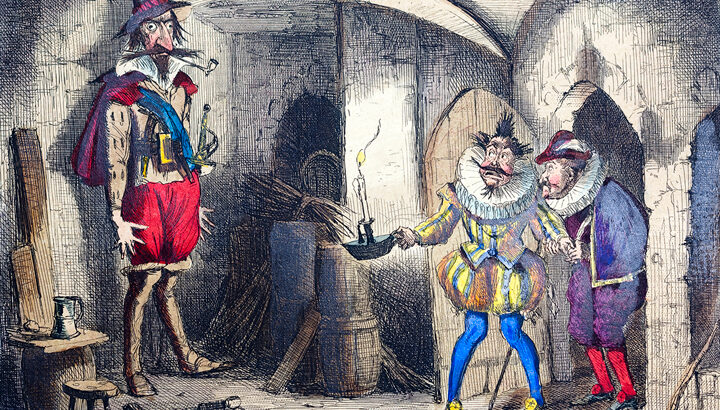I was surprised to see a French supermarket – in the Bordeaux region – dedicate a whole section of its space to Hallowe’en costumes and assorted such decorations, from witches’ hats to spooky skeleton costumes. Marking Hallowe’en had never, previously, been a French custom: but it has become one now, thanks to American merchandising tactics.
As we know – and as Martina Purdy pointed out last week – Hallowe’en is essentially a Celtic pagan custom, which lingered on in residual form in Christianity, but has now become much more pervasive.
Childhood
In my childhood, Hallowe’en was rather simple and, I would say, harmless. We played games like apple-bobbing and pinning a tail, blindfolded, on the image of a donkey. We did call around to neighbours’ houses and they gave us oranges or nuts, though the phrase “Trick or treat” wasn’t then part of the vocabulary.
Then the idea got exported to America, where it was turned into something much more commercialised, hyped-up – and re-exported to Ireland, Britain and now, Continental Europe in more intense marketised form.
It’s interesting to note how successful the marketisation of Hallowe’en has been in Britain, where it has virtually come to replace Guy Fawkes night on November 5.
Little by little, the tradition has declined, and you never see kids asking ‘a penny for the guy’ any more”
It was common, back in the day, to encounter London urchins accompanied by their straw mannikin asking for ‘a penny for the Guy’, in the run-up to Guy Fawkes night. There was a chant to go with it: “Remember, remember the Fifth of November/Gunpowder, treason and plot!”
This wasn’t pagan: it was about burning in effigy a Catholic rebel who had been horribly tortured even before he was executed. Poor Guy! I saw it as part of English history, though I also thought it a little sectarian.
Indeed, in Sandymount, Dublin 4 – where inter-faith relations were harmonious – some of the local Protestant children did burn their ‘Guy’ on November 5. I remember envying their impressive fireworks, like rockets and Catherine wheels.
But fireworks have been part of Guy Fawkes’ decline: Health and Safety has increasingly frowned on the mixture of bonfires and fireworks around children, and frightened pets. Little by little, the tradition has declined, and you never see kids asking “a penny for the guy” any more. Now, they’re more likely to be focused on witches and warlocks for Hallowe’en.
The pagan roots of Hallowe’en are evident, and the marketisation slick. Yet I wouldn’t take the whole event too seriously. As the evenings grow darker, spooky images can be seen as a reflection of nature’s cycles. We can smile at Hallowe’en antics while turning our attention to the feasts of All Saints and All Souls.
A novelist makes things up
The short novel Small Things Like These, by Claire Keegan, has had a huge success with the book-buying public, and was generally highly praised. It is very well-written, in spare, skilful prose. The movie, starring Cillian Murphy, will be in cinemas shortly, and has been widely publicised in advance. It is garlanded with awards, and I’m sure it will be artistically admirable.
The storyline centres on an Irish Magdalene home for unmarried mothers in which the young women are kept as virtual prisoners by stern, sly, controlling nuns. A local man, Bill Furlong, played by Murphy, discovers this secret and tries to help one of the girls escape.
My problem with this narrative is the date in which it is set – 1985. I could believe the storyline if it were set in 1955, or even, perhaps, 1965. But 1985? How many single mothers were kept against their will in Magdalene homes in the middle 1980s? Single mothers had the entitlement to claim child allowance benefits from 1973. The numbers of babies born out of wedlock were rising every year from 1980 (when it was 5%), and in 1985, the percentage stood at 8.5% – that is, some 5,282 infants born to unwed mothers. (This would reach one-third of all births by 2005.)
There had been a heated national debate in 1983 over abortion, in which conservative Catholics were heard to praise single mothers for having a baby rather than an abortion. Is it really plausible that at that time there were young women so bereft of civil rights, social support, family connections or recourse to the law that they were held against their will or consent behind convent walls? Very hard to believe. But then the job of a novelist is to make things up.
*
I came away from The Apprentice – Ali Abbasi’s movie about the rise of Donald Trump – thinking that he really is an unpleasant character, who had also been corrupted by his mentor Roy Cohn. But an anti-Trump friend came away with the opposite view: that the movie showed Trump as a vulnerable young man (with a horrible father) just aiming for the American dream. De gustibus non est disputandem – opinions differ.










 Mary Kenny
Mary Kenny
